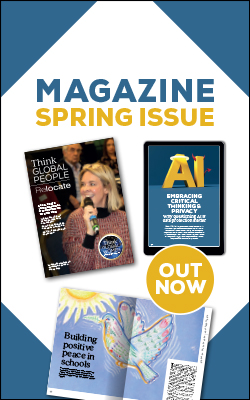AI in education
Educators need to shape the use of AI in education, as with every benefit AI brings comes with it a risk. Ledetta Asfa-Wossen reports on a recent Westminster Education Forum.


This article is taken from the Spring 2024 issue of
Think Global People magazine
Click on the cover to access the digital edition.Educators, tech companies and policymakers gathered to discuss the use of AI across education and ways for navigating a clearer path forward.Labour MP Dawn Butler and vice chair of the All-Party Parliamentary Group for AI set the tone by urging delegates to look at how they manage the risks and rewards of AI.“We're not going to be able to stop the advancement of AI. What we do have to take responsibility for are the guardrails around that. Where we allow it to be and what we allow AI to do. And in reverse of that, what we don't allow and what we say is unacceptable.”Butler remarked that teachers will be as critical as they have always been. Schools will need to teach fundamental ethics and key human skills, particularly around consent and critical thinking, even more so in an AI age and have a deep understanding of bias.In a thought-provoking opener, Sir Anthony Seldon, emeritus professor at the University of Buckingham and author of ‘The Fourth Education Revolution’, asked delegates whether AI would liberate or infantilise humanity. Seldon listed some ongoing concerns, namely the need for a common language when it comes to AI. He also warned educators to not be too trustful of tech companies and that educators need to work closely with them to better shape these tools.“We need to understand how broad AI goes. For example, does it include virtual reality with its powerful impact on social sciences and physical sciences? What does AI include and not include? What are the benefits? Are they just inside the class or also outside of it? We need a common language and we are getting there. But we're not there yet,” he added.Seldon called for the need to be precise about what it is we are saying about AI, regardless of where you sit on the topic, and that arguments for and against are often unclear.
Read related articles from Relocate Global
- Computational thinking for an AI age
- Preparing for the AI revolution in education, business and governance
- How do we flourish in the age of AI?
Opportunities for AI
While it was clear from discussions that parameters are needed as AI use grows, some speakers noted the powerful benefits it can have. Mental health support was one area, particularly for younger age groups that might benefit from personalised support tools, as well as developments that are helping to achieve quicker mental illness diagnosis.When used appropriately, generative AI was noted to have the ability to reduce workload for teachers. Sam Illingworth, associate professor at Edinburgh Napier University, listed some opportunities for AI in education, but stressed the importance of involving students in the process and understanding how students use AI and why they use it.Other opportunities included delivering more personalised education by tailoring learning experiences to individual student profiles and abilities. The potential for AI to further enhance classroom interaction and overcome language barriers in multicultural classrooms was also marked as a plus. Not to mention administration efficiencies that can allow teachers to focus more on learning design or having more time for creativity.Emma Darcy of Denbigh High School gave some examples of how AI is helping to improve school attendance and educational attainment. She noted that AI literacy and capability can’t be reserved only for IT professionals or tech subjects. Darcy gave an interesting example of how even an RE teacher discussing the soul would need to understand AI to sufficiently teach ideas around religion, ethics and philosophy.Darcy further stressed that the use of AI varies in each context and is often subtler than we think. “There are a number of good tools that use AI integrated in them. It doesn’t necessarily mean it’s an AI lesson. More, that we’re using tools that use AI, like scheduling tools or Canva, that can help with lesson planning and learning, rather than explicitly talking to a high level about large language models.”Looking at the current adoption of AI in education, RM Technology’s Mel Parker, a former headteacher, shared how students are using AI. “Sixty-six percent of teachers believe they are receiving work that uses AI,” she said. According to Parker, a fifth of students use AI to do all their schoolwork, while 68% of students also felt they were getting better results using AI. However, one in ten teachers surveyed also found it hard to detect whether students were using AI in their classwork.Parker also discussed that there is still some guilt associated with using AI among students, regardless of the positive benefits it can have. Four in ten students felt guilty about their use of AI. Even though AI can help teachers generate learning materials, create more interactive learning and help reduce repetitive administrative tasks, guilt was also recorded among schoolteachers for using AI tools in their work.Challenges aheadAlong with some of the benefits of AI use were a host of concerns. Some panellists discussed the challenges around assessment and ongoing issues around cheating and plagiarism.Data, security and privacy were also key concerns for schools when using AI tools. Parker noted it was important that sensitive data should not be used in public models and that schools and educators need support in configuring AI tools for safe and secure use. Perhaps more pressingly she noted, “schools need to be more aware than ever of what data they store where and who in particular has access to it.”Sam Illingworth expressed other challenges with AI. In particular, the risk of exacerbating educational inequalities due to varying levels of access to advanced technology. He warned attendees of the inherent biases of AI and the potential for it to shape the curriculum and perpetuate stereotypes.Academic integrity was a common thread on the day and the need to understand the impact of AI-generated content on assessments. There was also growing uncertainty about how students view AI as educational aids and threats to overall integrity.Sonja Hall, principal education official at teachers’ union the NASUWT, added that it must not be presumed that AI will reduce workloads and benefit all teachers or students because for many the outcome can vary and depends on several additional factors.She also echoed thoughts from Seldon that AI or edtech benefits are often made by tech companies and so must be analysed more.While Priya Lakhani, founder of Century Tech and co-founder of The Institute of Ethical AI in Education spoke on how students need to not only understand AI for productivity, learning and work, but they also need an understanding of: how AI models work, how to question the data sets that information is modelled on, how that data is used, and how to verify information and identify bias.Back to basics
The bulk of sessions indicated that more work lies ahead, particularly around basic processes and structures to implement, manage and regulate the use of AI in education.“We don’t really have a national picture of what is happening with AI in our schools and colleges across the UK,” said Professor Rose Luckin. “We need to benchmark it. Once we know where we are and get an accurate picture of what is happening, we can get correctly involved and build our voice. Then we can provide better support and build the capacity for AI so it can be used as effectively and safely as possible for the benefit of everyone.”Luckin noted that AI can be a powerful tool, but that firm frameworks are essential to help institutions effectively develop AI capability in schools. Her advice to educators, educational institutions and other organisations looking to implement AI?Five steps to introducing AI in organisations1) Start with a clear vision and understand your values. Really think about how AI is going to help you achieve this faster, better and in a more impactful way.2) Focus on governance and ethics: what are the parameters in your organisation and where AI is going to be used?3) Keep the process iterative and learn as you go.4) Think about your whole technology and data infrastructure: what do you need to use AI effectively; do you need to build it; and how?5) Lastly, look at your staff capability; how exactly are you going to build that as well as what specific AI use you need capability for.There’s a long road ahead. But both delegates and speakers seemed to agree that while collaboration among educators, tech and government is vital, educators should steam ahead to lead and shape what AI looks like in education. And time is of the essence.Read the latest issue of Think Global People magazine. Read your copy here.

Find out more about the Think Global People and Think Women community and events.

Subscribe to Relocate Extra, our monthly newsletter, to get all the latest international assignments and global mobility news.Relocate’s new Global Mobility Toolkit provides free information, practical advice and support for HR, global mobility managers and global teams operating overseas.
©2025 Re:locate magazine, published by Profile Locations, Spray Hill, Hastings Road, Lamberhurst, Kent TN3 8JB. All rights reserved. This publication (or any part thereof) may not be reproduced in any form without the prior written permission of Profile Locations. Profile Locations accepts no liability for the accuracy of the contents or any opinions expressed herein.




































